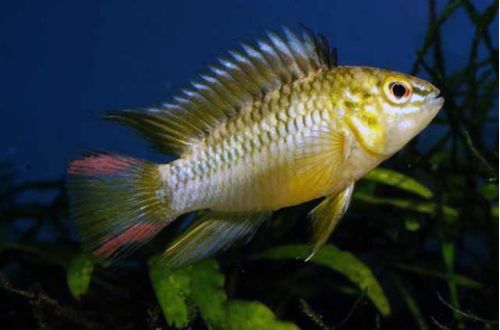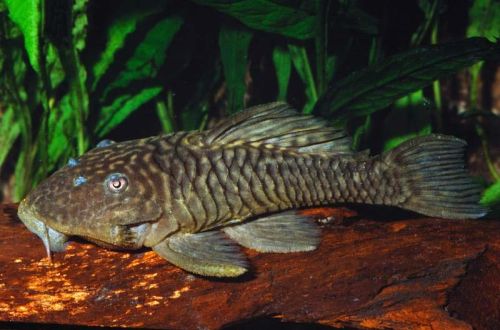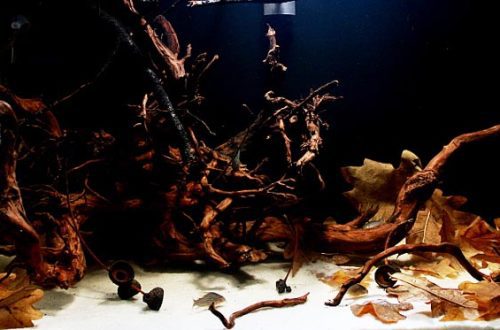
Apistogramma Hongslo
Apistogramma Hongsloi, scientific name Apistogramma hongsloi, belongs to the Cichlidae family. Easy to keep bright beautiful fish with complex intraspecific relationships. Under the same name, several subspecies were supplied at once, but outwardly they differ little and are currently mixed with each other, giving hybrid offspring.

Contents
Habitat
It comes from South America from the territory of modern Colombia and Venezuela. It lives in the river systems Vichada (Rio Vichada) and Meta (Rio Meta), and after the confluence of these rivers with the Orinoco, further downstream. Prefers small tributaries with slow water movement and quiet pools.
Brief information:
- The volume of the aquarium – from 40 liters.
- Temperature – 23-29°C
- Value pH — 5.5–7.0
- Water hardness – soft to medium hard (1-15 dGH)
- Substrate type – sandy
- Lighting – subdued
- Brackish water – no
- Water movement is weak
- The size of the fish is 4–6 cm.
- Food – any feed, meat is preferred
- Temperament – peaceful, except during spawning periods
- Keeping in a group with one male and several females
Description

Adult males reach a length of up to 6 cm, females – up to 4.5 cm. Red and yellow shades dominate in the variegated color. A dark stripe runs along the lateral line. Males look more colorful than females.
Food
Refers to carnivorous species. In nature, it feeds mainly on benthic invertebrates. However, the aquarium will accept dry food. It is advisable to diversify the diet with live or frozen foods, such as brine shrimp, bloodworms, daphnia, etc.
Maintenance and care, arrangement of the aquarium
The size of the aquarium for one pair of fish starts from 40 liters. Apistogramma Hongslo is unpretentious in design and can be kept in various conditions with the appropriate hydrochemical composition of water. However, the use of decorative elements characteristic of the natural habitat is encouraged. For example, a sandy substrate, thickets of shade-loving plants, branched snags that form shelters. The lighting is subdued.
In nature, the bottom of the rivers is littered with plant remains and leaves of trees. You can also add a few oak leaves to the aquarium, previously dried and then soaked so that they begin to sink. Indian almond leaves will give the best results. The leaves, when decomposed, will become a valuable food source for fry, and the substances they contain, such as tannins, will color the water to a tea color. A similar shade of water is characteristic of reservoirs in the habitat of this species.
When keeping, it is important to ensure high water quality. To do this, you will need to install a productive filtration system, regularly clean the aquarium from organic waste and replace part of the water (10–15% of the volume) with fresh water weekly. It is worth remembering that when choosing and placing a filter, a strong current should not be allowed to occur.
Behavior and Compatibility
Apistogramma Hongslo gets along well with other non-aggressive species of comparable size. Intraspecific relationships are built on the dominance of the alpha male, so it is recommended to keep in a male / female pair or as a harem.
Breeding / breeding
During the spawning period, the male becomes overly aggressive, so it is advisable to breed in a separate or very large aquarium in order to avoid possible problems with neighbors and relatives. The female lays her eggs in cracks or voids in the decoration and remains with the clutch for protection. Caring for the offspring on her part continues even after the appearance of the fry. At the end of spawning, the male is returned back to the general aquarium.
Fish diseases
The main cause of most diseases is unsuitable living conditions and poor-quality food. If the first symptoms are detected, you should check the water parameters and the presence of high concentrations of hazardous substances (ammonia, nitrites, nitrates, etc.), if necessary, bring the indicators back to normal and only then proceed with treatment. Read more about symptoms and treatments in the Aquarium Fish Diseases section.





